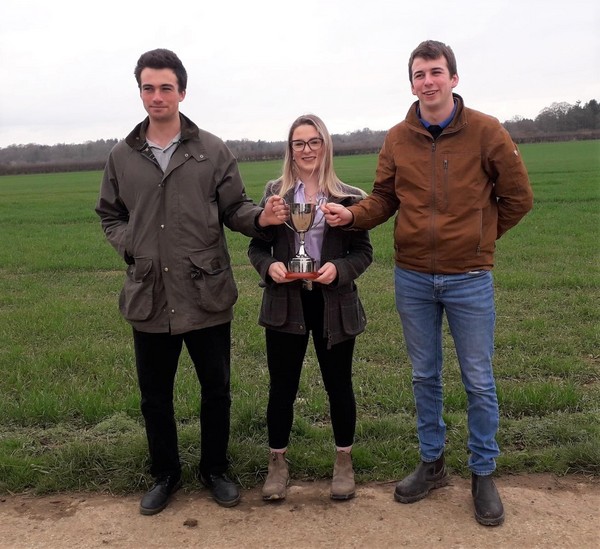A team of agriculture students from Aberystwyth University’s Institute of Biological, Environmental and Rural Sciences (IBERS) are the winners of the NIAB Agronomy Cup for the second year.
Philip Dray, Olivia MacGarvie, William Watson and Will Davies achieved the highest gross margin of £2,131/ha in the annual winter wheat trial plot competition, based on a yield of 12.24 t/ha and an input cost of £72.15/ha.

Caption: William Watson, Olivia MacGarvie and Philip Dray from IBERS-Aberystwyth University won the 2018 NIAB Agronomy Cup. Missing is team member Will Davies.
IBERS-Aberystwyth is the first team to lift the trophy twice since the competition began, after winning in 2017 and coming a close second in 2016. They beat six other university and colleges, with a team from Diss Young Farmers Club, in Norfolk, coming second and Lancashire’s Myerscough College taking third place.
The competition was carried out on the wheat variety KWS Siskin on five sites across the UK, although none of the teams achieved a milling specification this year.
Philip described the reasoning behind the IBERS-Aberystwyth’s technical recommendations. “There was already some septoria present in the crop by T0. By applying Bravo (a.i. chlorothalonil) at the T0 and T1 timing we hoped to slow the spread of the disease. We then used Ignite (a.i. epoxiconazole) at T1 to reduce the risk of yellow rust infection at the Hereford site.”
With KWS Siskin’s score of 6 for lodging the IBERS team applied a full rate of chlormequat at T1. “There was a high level of residual nitrogen in the soil, so we avoided additional nitrogen and, by adding a PGR, we hoped to prevent the crop from lodging,” said Philip.
By T2 the team had observed eyespot on the stem, so added Tracker (a.i. boscalid + epoxiconazole) as an eradicant and protectant, including reducing the further spread of septoria. They used Amistar Opti (a.i. azoxystrobin + chlorothalonil), for the chlorothalonil for additional septoria protectant activity, then added Folicur (a.i. tebuconazole) at T3 to prevent fusarium infection.
The winning 2018 NIAB Agronomy Cup crop recommendation
| Treatment | NIAB standard | IBERS-Aberystwyth | ||||||
| Early N | As farm crop | As farm crop | ||||||
| T0 | Cherokee @ 1.0 l/ha | Bravo 500 @ 1.5 l/ha | ||||||
| T1 | Tracker @ 1.0 l/ha + Bravo 500 @ 1.0 l/ha | Bravo 500 @ 2.0 l/ha + Ignite @ 0.75 l/ha | ||||||
| T2 | Adexar @ 1.5 l/ha | Tracker @ 1.125 l/ha + Amistar Opti @ 1.5 l/ha | ||||||
| T3 | Folicur @ 0.75 l/ha | Folicur @ 0.5 l/ha | ||||||
| T0 PGR | chlormequat @ 1.25 l/ha | CCC @ 2.0 l/ha | ||||||
| T1 PGR | chlormequat @ 1.0 l/ha | None | ||||||
| Late N | None | None |
“The IBERS-Aberystwyth teams have always been very diligent, considering how far they have to travel to check their plots,” said NIAB National Trials Co-ordinator Ian Midgley. “They took note of all the site information provided by NIAB staff, made good use of plot visits to our site at Hereford, identified the diseases present and understood the strengths and weaknesses of the competition variety.”
Across the five NIAB competition sites the highest treated yield was the IBERS plot in Hereford at 12.24 t/ha (102% of site standard). The lowest was 8.0 t/ha at Headley Hall in Yorkshire, 0.3 t/ha lower than the NIAB standard plots. The highest fungicide spend was at Cirencester with £124.60/ha, with plots only out yielding the NIAB standard of £92.08/ha by 0.121 t/ha. The lowest fungicide spend was £35.00/ha at Morley, out yielding a competitor’s plot by nearly 0.4 t/ha despite an additional £26.25/ha spend.
Final results 2018
- IBERS-Aberystwyth
- Diss Young Farmers Club
- Myerscough Colege
- Riseholme College
- Royal Agricultural College Team A
Plots are already ready and waiting for the 2019 competition entrants. Application forms for available to download or on application from ian.midgley [at] niab.com (Ian Midgley) at NIAB.
About the NIAB Agronomy Cup
The NIAB Agronomy Cup challenges a team’s agronomy, farm management and agricultural decision-making skills. It differs to other plot competitions as teams make input decisions on the same variety, the milling wheat KWS Siskin, but on a NIAB field trials site local to their college or university. The locality emphasises the importance of basing recommendations on field observations and local conditions.
The 2018 competition sites were at NIAB’s regional centres at Hereford, Morley, Cirencester, Headley Hall and Caythorpe. The fully replicated plot competition is judged on a number of factors, including margin as well as yield, so any site differences are compensated for.
The competition, which has been running since 2012, is open to agriculture and crop science students from universities and colleges and Young Farmers’ Club teams across the UK.
The winning team
The team are all studying for a BSc Agriculture at IBERS-Aberystwyth. Originally a FdSC Agriculture student Philip Dray is from a predominately beef and sheep farming background in north Herefordshire. He is delighted to be part of the winning team, appreciating how the competition allowed him to apply agronomy knowledge gained from course modules into real life, an opportunity he would not have on the farm at home.
With little arable background Olivia MacGarvie also wanted to use the competition to put her newly found agronomy knowledge to the test. She would like to eventually work in the arable sector, including gaining FACTS and BASIS qualifications. William Watson is from a south Devon organic dairy and mixed vegetable farm. Again he had had little opportunity to gain any experience in cereal production before the competition, and was pleased to apply the theory in a practical environment. And finally Will Davies, entered the competition to gain more practical applicable skills in an area of agriculture he was not actively involved in. His background is primarily beef and sheep farming and he is currently on placement in New Zealand.
